Army Lists
Regimental Standards and Cap Badges
1 - 10 | 11 - 20 | 21
- 30 | 31 - 40 | 41
- 50
| A Typical Pair
of Colours |
 |
 |
|
| King's |
Regimental |
|
In the British Army, all battallions of the Guards and of Line
Regiments carry two colours. With the former the King's Colour
is crimson, the Regimental Colour being the Union Jack, and
all the Battle honours are placed on each colour. In the Line
the Jack is the King's colour, and bears the Honours for the
Great War alone. The Regimental colour beats all the pre and
post Great War Honours. Heavy cavalry carry either a Standard
or a Guidon: Hussar, Lancer and Rifle regiments have no colours.
|
| The Royal Horse
Guards |
 |
 |
|
| King's Standard |
Regimental |
|
The King's Standards borne by the three regiments of Household
Cavalry (1st and Life Guards and Royal Horse Guards) are almost
all identical in appearance, for each bears the Royal Arms and
has all the Battle Honours of the Regiments embroidered underneath.
The Royal Horse Guards ("The Blues") wear, in full
dress, blue tunics with red facings and silver helmets with
scarlet plumes. Like the rest of the Household Cavalry they
wear the steel cuirass (or back and breast plates). The Blues
carry also a Regimental and a Squadron Standard. |
| 1st The Royal Dragoons
|
 |
 |
|
| Guidon |
Cap Badge |
|
"The Royals" carry a Guidon which bears 22 battle
Honours, the 12 pre-1914 distinctions on one side, and the 10
for the Great War, as illustrated, on the other. The Badge of
the regiment, seen in the centre of the Guidon and on the Cap
Badge, is the Royal Crest of the lion and crown. The golden
eagle in the base of the Guidon is borne in the memory of the
capture by the Royals of a French eagle and Waterloo. The motto
of the Regiment is "Spectemuragendo" ("Judge
us by our deeds"). |
| The Honourable
Artillery Company |
 |
 |
|
| King's Colour |
Cap Badge Infantry |
|
To the H.A.C., now a Territorial unit, must be given pride of
place as the oldest regiment in the British Army for its Charter
dates from August 25th 1537. The Colour illustrated, which,
with the blue Regimental Colour, was presented on June 25th
1928, is the only King's Colour in the Army (outside the Brigade
of Guards) to bear more than ten Battle Honours for the Great
War it carries "South Africa 1900-02". The Cap Badge
illustrated is that worn by the Infantry Battalion. |
| 1st Battalion Grenadier
Guards |
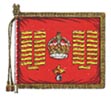 |
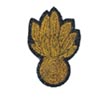 |
|
| King's Colour |
Officers' Cap Badge |
|
In the old days the Regiment of Foot Guards carried Royal Standards,
which, before the Act of Unison were of crimson silk. Hence
the King's Colours of the Guards are crimson nowadays, and the
Regimental Colours of the Brigade of Guards should not be confused
with the State Colours which are carried by them on State occasions.
No. 1 Company of the 1st Battalion is known as the King's Company,
and carries a colour of its own on occasion. Only picked men
of over six feet are found in its ranks. |
| 2nd Battalion Grenadier
Guards |
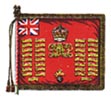 |
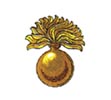 |
|
| King's Colour |
Cap Badge Men |
|
The King's Colours of the 2nd and 3rd Battalions of the Grenadiers
are similar, with the exception that the latter battalion shows
a "pile wavy" for difference (see 3rd
Battalion Coldstream Guards). As may be noticed, all the
Battle Honours appear on both King's and Regimental Colours
in the Guards. There are four types of Cap Badge, the Officers'
(see 1st Battalion Grenadier Guards), the Men's,
the Warrant Officers' (see 3rd Battalion Grenadier
Guards), and the Serjeants', the latter having the interlaced
cypher on the grenade in gold instead of silver. |
| 3rd Battalion Grenadier
Guards |
 |
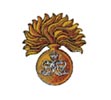 |
|
| Regimental Colour |
Cap Badge |
|
The Badge in the center of the Regimental Colour of the 3rd
Battalion of the Grenadier Guards is that of number XXX Company.
When the colours are renewes these badges change, each of the
30 Company Badges being borne in rotation, three at a time,
one on the Regimental Colour of each battalion. On the tunics
of the Grenadiers, formerly the 1st Foot Guards, the buttons
are placed singly. The bearskin plumes are white, but the cap
bands in the undress uniform for the ranks are red. The march
past is the well-known "British Grenadiers". |
| 1st Battalion Coldstream
Guards |
 |
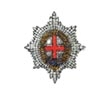 |
|
| Regimental Colour |
Officer's Cap Badge |
|
The Colours of the Coldstream Guards conform to the usual custom
in the Brigade of Guards, all the Battle Honours being emblazoned
on each colour, while a Regimental Colour bears the Company
Badge in the centre. The Badge shown is that of No 21 COmpant.
The regiment was formed in 1650 from Fenwick's and Hesilrige's
Regiments of Foot, and Monck was its first Colonel. When the
Restoration was accomplished, the regiment was at Coldstream,
and marched to London, hence the name "Coldstreamers"
(never "Coldstreams"). |
| 2nd Battalion Coldstream
Guards |
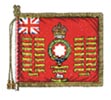 |
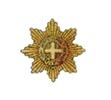 |
|
| King's Colour |
Cap Badge |
|
The Badge of the COldstream Guards is the Star of the Order
of the Garter, the premier British Order of Knighthood. The
King's Colour of the 2nd Battalion is different from those borne
by the other two battalion (see 3rd Battalion
Coldstream Guards). While the Grenadiers were known as the
1st Regiment of Foot Guards, the scornful motto of the Coldstreamers,
"Nulli Secundus" (Second to None) was the result of
the implication that they were the 2nd Regiment of Guards. The
regiment marches past to "Milanello", and air it shares
with no other regiment of the British Army. |
| 3rd Battalion
Coldstream Guards |
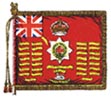 |
 |
|
| King's Colour |
Cap Badge |
|
The King's Colour of the 3rd Battalion is similar to that borne
of the 1st Battalion, except that the Union Flag appears in
the corner, and with the "pile wavy" differences it,
for the 1st Battalion has no Jack or pile, while the 2nd Battalion
has the Jack and also has a different central device (see 2nd
Battalion Coldstream Guards). The buttons on the Coldstreamers
coats are placed in pairs, the plume of the bearskin is red,
and the band of the forage cap is white. As shown on this page,
the Cap Badges of the Officers, W.O.s and other ranks are different.
|
|